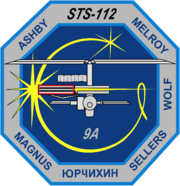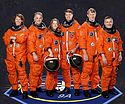STS-112
| STS-112 | |||||
 | |||||
| Uppdrag | 111 | ||||
|---|---|---|---|---|---|
| Rymdfärja | Atlantis (26)[1] | ||||
| NSSDC-ID | 2002-047A[2] | ||||
| Färdens tid | 10 dagar, 19 timmar, 58 minuter, 44 sekunder | ||||
| Uppskjutning | |||||
| Startplats | Pad 39B vid Kennedy Space Center i Florida | ||||
| Start | 7 oktober 2002 19:45:51 UTC | ||||
| Landning | |||||
| Landningsplats | KSC Runway 33 | ||||
| Landning | 18 oktober 2002 15:44:35 UTC | ||||
| Omloppsbana | |||||
| Varv | 170 st[3] | ||||
| Apogeum | 234 km | ||||
| Perigeum | 156 km | ||||
| Banlutning | 51,6° | ||||
| Sträcka | 7,2 miljoner km | ||||
| Rymdpromenad | |||||
| Antal | 3 st | ||||
| Total tid | 19 timmar, 41 minuter | ||||
| Dockning | |||||
| Rymdstation | ISS | ||||
| Dockning | 9 oktober 2002 15:16 UTC | ||||
| Dockningsport | PMA-2 (Destiny, fram) | ||||
| Urdockning | 16 oktober 2002 13:13 UTC | ||||
| Tid dockad | 6 dagar, 21 timmar, 57 minuter | ||||
| Besättning | |||||
| Befälhavare | Jeffrey Ashby (3) | ||||
| Pilot | Pamela Melroy (2) | ||||
| Uppdragsspecialister | David A. Wolf (3) Piers J. Sellers (1) Sandra H. Magnus (1) Fjodor Jurtjichin (1) Ryssland | ||||
 | |||||
| Kronologi Rymdfärjeprogrammet | |||||
| |||||
STS-112 var en flygning i USA:s rymdfärjeprogram. Flygningen genomfördes med rymdfärjan Atlantis. Den sköts upp från Pad 39B vid Kennedy Space Center i Florida den 7 oktober 2002. Efter nästan elva dagar i omloppsbana runt jorden återinträdde rymdfärjan i jordens atmosfär och landade vid Kennedy Space Center.
Flygningen gick till Internationella rymdstationen, ISS.
Flygningens mål var att leverera Truss S1 och installera den på Truss S0.
Rymdpromenad
Under flygningens tre rymdpromenader monterades och installerades Truss S1.
Statistik
Besättning
- Jeffrey Ashby (3), befälhavare
- Pamela Melroy (2), pilot
- David A. Wolf (3), uppdragsspecialist
- Piers J. Sellers (1), uppdragsspecialist
- Sandra H. Magnus (1), uppdragsspecialist
- Fjodor Jurtjichin (1), uppdragsspecialist
Väckningar
Under Geminiprogrammet började NASA spela musik för besättningar och sedan Apollo 15 har man varje "morgon" väckt besättningen med ett musikstycke, särskilt utvalt antingen för en enskild astronaut eller för de förhållanden som råder.
| Dag | Låt | Artist/Kompositör | Spelad för | Länk |
|---|---|---|---|---|
| 2 | “Venus and Mars” | Paul McCartney and Wings | David Wolf | wav |
| 3 | “The Best” | Tina Turner | Jeffrey Ashby | wav |
| 4 | tema från "The Monkees", "Rocket Man", "Space Oddity", "I am Woman" | The Monkees, Elton John, David Bowie, Helen Reddy | Sandra Magnus | wav |
| 5 | “Oh Thou Tupelo” | Wellesley College Choir | Pamela Melroy | wav |
| 6 | “Push It” | Garbage | Piers Sellers | wav |
| 7 | “Marsj aviatorov” | Ryska luft- och rymdförsvarsstridskrafternas marsch | Fjodor Jurtjichin | wav |
| 8 | “You Gave Me the Answer” | Paul McCartney and Wings | David Wolf | wav |
| 9 | “Only an Ocean Away” | Sarah Brightman | Sandra Magnus | wav |
| 10 | “Prime Time" | The Alan Parsons Project | Pamela Melroy | wav |
| 11 | “These Are Days” | 10,000 Maniacs | Piers Sellers | wav |
| 12 | “Someday Soon” | Suzy Bogguss | Jeffrey Ashby | wav |
Galleri
- Atlantis med Integrated Truss Structure
- Astronaut Piers J. Sellers på den andra av tre rymdvandringar under STS-112
Se även
Referenser
- ^ NASA Space Shuttle Launch Archive Arkiverad 9 juni 2014 hämtat från the Wayback Machine., läst 28 juli 2016.
- ^ ”NASA Space Science Data Coordinated Archive” (på engelska). NASA. https://nssdc.gsfc.nasa.gov/nmc/spacecraft/display.action?id=2002-047A. Läst 22 mars 2020.
- ^ Manned Astronautics - Figures & Facts Arkiverad 16 augusti 2016 hämtat från the Wayback Machine., läst 28 juli 2016.
Externa länkar
 Wikimedia Commons har media som rör STS-112.
Wikimedia Commons har media som rör STS-112.
| ||||||||
| |||||||||||||||||||||||||||||||
| ||||||||||||||||||||||||||||||||
Media som används på denna webbplats
Rotated and color enhanced version of original (ISS013-E-48788 (6 July 2006) --- The Space Shuttle Discovery approaches the International Space Station for docking but before the link-up occurred, the orbiter went through a series of inspection photos by station crew to inspect the vehicle for any damage to its Thermal Protection System. This was known as the Rendezvous Pitch Maneuver and was implemented after the Columbia Disaster in 2003. The Leonardo Multipurpose Logistics Module can be seen in the shuttle's cargo bay. Discovery docked at the station's Pressurized Mating Adapter 2 at 9:52 a.m. CDT, July 6, 2006.)
Backdropped by a blue and white Earth, this close-up view features the Soyuz TMA-6 spacecraft approaching the International Space Station (ISS). Onboard the spacecraft are cosmonaut Sergei K. Krikalev, Expedition 11 commander representing Russia's Federal Space Agency; astronaut John L. Phillips, NASA ISS science officer and flight engineer; and European Space Agency (ESA) astronaut Roberto Vittori of Italy. The Soyuz linked to the Pirs Docking Compartment at 9:20 p.m. (CDT) on April 16, 2005 as the two spacecraft flew over eastern Asia. The docking followed Friday’s launch from the Baikonur Cosmodrome in Kazakhstan.
In this illustration, a SpaceX Crew Dragon spacecraft approaches the International Space Station for docking. NASA is partnering with Boeing and SpaceX to build a new generation of human-rated spacecraft capable of taking astronauts to the station and expanding research opportunities in orbit. SpaceX's upcoming Demo-1 flight test is part of NASA’s Commercial Crew Transportation Capability contract with the goal of returning human spaceflight launch capabilities to the United States.
Författare/Upphovsman: Pascal (Flickr user: pasukaru76), Licens: CC0
Vostok spacecraft replica at the Technik Museum Speyer, Germany.
STS111-S-001 --- The STS-111 patch symbolizes the hardware, people, and partner nations that contribute to the flight. The Space Shuttle rises on the plume of the Astronaut Office symbol, carrying the Canadian Mobile Base System (MBS) for installation while docked to the International Space Station (ISS). The mission is named UF-2 for ISS Utilization Flight number two. The ISS orbit completes the Astronaut Office symbol and is colored red, white, and blue to represent the flags of the United States, Russia, France, and Costa Rica. The Earth background shows Italy, which contributes the Multi Purpose Logistics Module (MPLM) used on this flight to re-supply ISS. The ten stars in the sky represent the ten astronauts and cosmonauts on orbit during the flight, and the star at the top of the patch represents the Johnson Space Center, in the state of Texas, from which the flight is managed. The names of the STS-111 crew border the upper part of the patch, and the Expedition Five (going up) and Expedition Four (coming down) crews’ names form the bottom of the patch. The NASA insignia design for Shuttle flights is reserved for use by the astronauts and for other official use as the NASA Administrator may authorize. Public availability has been approved only in the forms of illustrations by the various news media. When and if there is any change in this policy, which is not anticipated, the change will be publicly announced.
Atlantis carrying the S1 Truss segment shortly before docking to the International Space Station, on mission STS-112. NASA photo ISS005-E-16524 take October 9, 2002. :This view of the Space Shuttle Atlantis was photographed by an Expedition Five crewmember onboard the International Space Station (ISS) during rendezvous and docking operations. Docking occurred at 10:17 a.m. (CDT) on October 9, 2002. The S1 (S-One) Truss, which is scheduled to be attached to the station and outfitted during three spacewalks, can be seen in Atlantis’ cargo bay. Notice the Canadarm can also be seen near the top of the cargo bay.
* This is the crew patch for the STS-113 mission, which will be the eleventh American (11A) assembly flight to the International Space Station (ISS). The primary mission will be to take the Expedition Six crew to the ISS and return the Expedition Five crew to Earth. STS-113 will be the first flight in the assembly sequence to install a major component in addition to performing a crew exchange. The Port 1 Integrated Truss Assembly (P1) will be the first truss segment on the left side of the ISS. P1 will provide an additional three External Thermal Control System radiators, adding to the three radiators on the Starboard 1 (S1) Integrated Truss Assembly. The installation and outfitting of P1 will require three extravehicular activities (space walks) as well as coordination between the Shuttle Robotic Manipulator System and the Space Station Robotic Manipulator System. The patch depicts the Space Shuttle Endeavour docked to the ISS during the installation of the P1 truss with the gold astronaut symbol in the background.
- The seven stars at the top left center of the patch are the seven brightest stars in the constellation Orion. They represent the combined seven crew members (four Shuttle and three Expedition Six). The three stars to the right of the astronaut symbol represent the returning Expedition Five crew members. The Shuttle crew names are on the solar arrays of the P6 truss. The ISS Expedition crew names are in a chevron that also features the American and Russian flags. The Expedition 6 crew names are on top of the Expedition 5 crew names, since Expedition 6 goes up while Expedition 5 goes down. The Roman Numeral CXIII represents the mission number 113.
These five astronauts and cosmonaut take a break from training to pose for the STS-112 crew portrait. Astronauts Jeffrey S. Ashby and Pamela A. Melroy, commander and pilot, respectively, are in the center of the photo. The mission specialists are, from left to right, astronauts Sandra H. Magnus, David A. Wolf and Piers J. Sellers and cosmonaut Fyodor Yurchikhin, who represents Rosaviakosmos.
The STS-112 emblem symbolizes the ninth assembly mission (9A) to the International Space Station (ISS), a flight which is designed to deliver the Starboard 1 (S1) truss segment. The 30,000 pound truss segment will be lifted to orbit in the payload bay of the Space Shuttle Atlantis and installed using the ISS robotic arm. Three space walks will then be carried out to complete connections between the truss and ISS. Future missions will extend the truss structure to a span of over 350 feet so that it can support the solar arrays and radiators which provide the electrical power and cooling for ISS. The STS-112 emblem depicts ISS from the viewpoint of a departing shuttle, with the installed S1 truss segment outlined in red. A gold trail represents a portion of the Shuttle rendezvous trajectory. Where the trajectory meets ISS, a nine-pointed star represents the combined on-orbit team of six shuttle and three ISS crew members who together will complete the S1 truss installation. The trajectory continues beyond the ISS, ending in a six-pointed star representing the Atlantis and the STS-112 crew.
Astronaut Piers J. Sellers, STS-112 mission specialist, uses both a handrail on the Destiny Laboratory and a foot restraint on the Space Station Remote Manipulator System (SSRMS) or Canadarm2 to remain stationary while performing work at the end of the STS-112 mission's second spacewalk. A cloud-covered Earth provides the backdrop for the scene.















